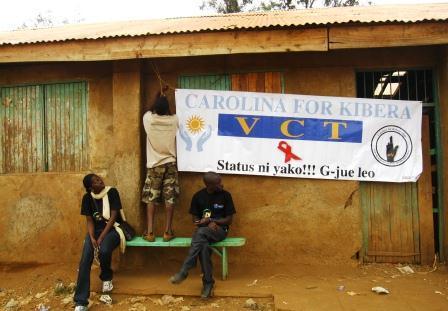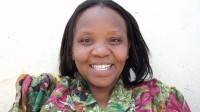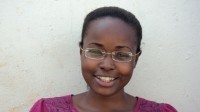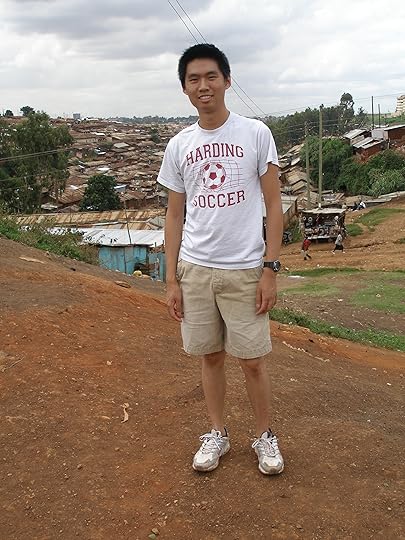Rye Barcott's Blog, page 25
July 19, 2011
Off To The United States For A Mission
By Thomas Bwire
30th June 2011
The cold June weather seemed to take a toll on Nairobi residents. As I waited at the Kobil petrol station along Haile Saielase Avenue at around 12.40pm, I could see most of the people walking past where I stood dressed in heavy attire. "Perhaps winter had already arrived in East Africa," I thought to myself as I waited patiently for Philip Innocent Nyangori, who was coming from Kibera on the way to the airport.
Vehicles going towards Mombasa Road passed continuously until I finally lost count of how many vehicles had passed. From the opposite direction, vehicles coming into town were stuck in traffic while two police officers attempted to control the traffic.
I didn't realize how quickly time had flown by until I received a call from Innocent, who informed me that they were at
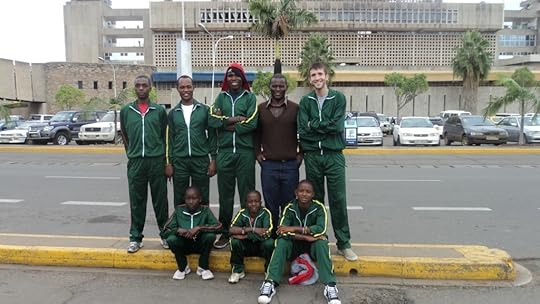
Upper Hill on their way to pick me up. I became a bit anxious as thoughts began running through my head about theirupcoming trip to the US. In less than five minutes, however, a passenger seated on the left-hand side of a matatu waved to me. "Oh, here they are," I said to myself as I quickly boarded the matatu and began to head towards the airport. Inside the van, Innocent introduced me to Michael Fry, the project coordinator of One World One Rope. I also met Diana Adhiambo, representing the Carolina for Kibera Jump Rope Program, as well as five other participants from neighboring Tanzania. Michael and the jump rope participants all wore green jerseys with athletic shoes and looked as neat as one family.
Traffic flow was relatively light and in less than ten minutes we were able to make a brief stopover at Nakumatt Malls along Mombasa Road so that Michael could make photocopies of the jump ropers' online flight tickets.
Inside the van, Diana Adhiambo (the only participant from Carolina for Kibera), smiled at me as we greeted each other. "How are you today?" I said to start the conversation.
"I am fine" answered Diana.
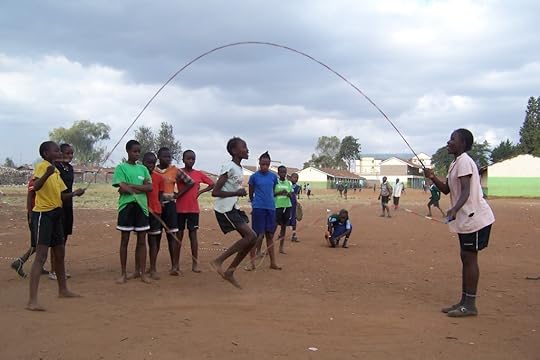
"Are you happy to be among the participants going to the US?"
"Yes, I am happy," she responded, as tears of joy rolled down her cheek. Nevertheless, she managed to smile as she faced me. For a few seconds I found myself drowned in thoughts of how Diana must have been feeling,
"I am going out of the country far, far away from my mother, my friends, my teachers and the people I am used to. What is in store for me in the new land I am going to?" – Perhaps these were Diana's thoughts.
Read more about what is in store for the jump rope participants in the United States in our next week's blog post covering the power of talent, even from the humble beginnings of the CFK Team.
July 6, 2011
Social Insurance Done Kibera Style
When we think of social insurance, we think of government-sponsored benefits programs funded by taxpayers. In Kibera, however, the flavor is very different – much more personal and intimate. Besides that, its ramifications are more real – directly observable and tangible. But what exactly embodies or defines social insurance in Kibera?
First of all, the Kenyan government does not sponsor any social welfare or benefits programs in Kibera. This means that despite paying due taxes, the people have no safety net provided by the government to protect them from any form of risk. Can you imagine not receiving any unemployment benefits after losing your job, or entirely relying on your own savings for retirement, or having to pay for all of a health bill that you can't afford in the first place? Those are just a few examples of the problems that the people of Kibera must overcome in the face of a passive and, at times, negligent government. As a result, they have been forced to create their own kind of social insurance – Kibera style.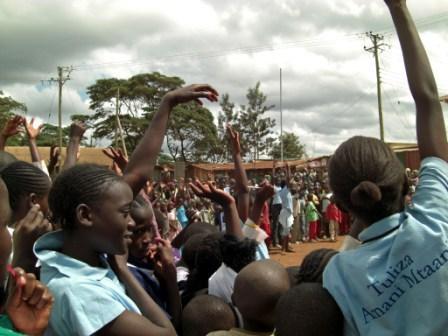
I spoke with CFK Education Program Assistant David Ngira to gain some perspective on social insurance at the individual and the community level. For David, social insurance is based on friends, relatives, and connections. The higher the number of these relationships that you have, the higher your respective level of "insurance" is. Thus, it follows that people with more social relationships are much less likely to find themselves without shelter, food, medical treatment, care for their children, and much more.
What does this tell us about the social fabric of Kibera, or more importantly, what generates the particular social fabric? People in Kibera are actually strongly motivated, by more than mere gregarious whims – they are motivated towards befriending their neighbors and maintaining relationships with their relatives and meeting new people of all types because doing so actually insures them against risk, however intangible the "insurance coverage" may be.
Of course, it would be overly simplistic to think that social insurance is the only factor that drives people to connect with each other. While there is a significant self-interested aspect of social insurance, it also springs from altruism – having empathy, common experience, and common understanding with other community members moves individuals to look out for each other. When one community member sees another starving from unemployment or struggling to keep their children in school, they immediately understand – they've been there too.
But social insurance takes many shapes and forms in Kibera – another important one of which is as currency, a simple form of exchange. Community members in Kibera look out for each other because they care for each other and have common understanding in circumstances and experiences, but also because they want to care for themselves. When one community member helps out another community member, it is unofficially unders
tood that in the future, there should be some kind of reciprocal treatment. One community member is trading, no, investing some of his or her wealth in times of prosperity for security in an uncertain future that might yield times of severe poverty and need.
In fact, there are numerous small, loose social welfare institutions in Kibera that operate informally and are largely based on clan or other group identities. Each member contributes a small lump sum of money each month to the association, which keeps the money in a collective coffer. This money is then available for emergencies for members in the association – death, funeral arrangements, transportation, medical care, childcare, etc. David himself is a member of the Sarika Village Welfare Association – Sarika Village is his hometown, and thus the Association is arranged in a clan-like manner.
Other examples of social insurance as currency are even more simple and clear-cut. In times of violence, most recently during the post-election violence in 2008, groups of young men offered security to neighbors and communities in return for quarters and meals.
But, one might wonder, how exactly are these loose social welfare institutions different, or better than a large, formal social insurance institution? CFK Program Officer Darius Isaboke offered his insight on the matter.
"The social welfare associations of Kibera are more operational when you have an issue; especially when you have an issue that you yourself cannot manage. Other institutions cover you out of damage or risk, which in many cases is indeterminate, making claims very difficult. The associations also work more broadly – they can cover anything from funeral arrangements to children's education, and any other issues that the community collectively views as important. As a result, the majority of people in Kibera, say, 75% belong to some sort of informal or formal social insurance association."
And what would Kibera be like without social insurance?
No one that I spoke to wanted to consider too deeply the implications of losing one of the foundational institutions of Kibera society. People's opportunities would be severely compromised – children would lose the opportunity to attend school, others the opportunity to start a business and seek a better life, others the opportunity to see their loved ones sent off in a proper burial ceremony, and others the opportunity to live a healthy life or simply, to live.
In the end, Darius concluded with a resounding affirmation of social insurance's important niche in Kibera.
"People would have many problems if they were on their own and would have an extremely difficult time handling them. Eventually, people would realize that they would have to come back to some sort of social insurance scheme in Kibera."
Follow Kevin's blog at- http://kevindiao.wordpress.com/
June 17, 2011
From Kibera, Kenya to Oslo, Norway
We do this work because we believe that talent is universal, but opportunity is not. The story below is a great reminder of that simple, transformative belief.
Every day, in the small open space in the dense slum of Kibera, kids are playing soccer. They play not for fame or money, but for love of the game. The game offers a respite from the daily challenges of life in a slum. It allows kids to be kids. It brings friends together. It provides a forum for coaches to be positve role models and teach about life on and off the field. Using the love of soccer, Carolina for Kibera's youth soccer program engages more than 5,000 players and hundreds of coaches and volunteers in multi-ethnic teams across Kibera, culminating in an annual tournament drawing thousands of spectators.
But never did the players in CFK's soccer teams think they would have a chance to play in an international tournament. Until this year.
This year, 10 youth and 3 coaches from the CFK's sports program have been invited to participate in the prestigious Norway Cup 2011 in Oslo, Norway. The invitation is quite an honor, as this is the first time any teams from Kibera have been invited to participate. For all of our players, this will be the first time they will leave Kenya, for some it will be the first time they venture outside Nairobi. This world-wide soccer tournament is a once-in-a-lifetime opportunity that brings together children and youth between 12 and 19 years from around the world for a week of fun, sporting, education, and cultural exchange.
"Through their personal stories & experiences from Kibera, they will add as much value to the Norway Cup, as they will benefit from the exposure." – Abdul Hussein, Sports Program Officer, Carolina for Kibera
The tournament takes place at the end of July, so we do not have much time to collect the $25,000 needed to send the team. All the expenses and fees for the tournament are covered, we only need to raise funds for the cost of airfare and passport fees. To learn more about this incredible opportunity and donate, please visit the project page on Global Giving. Global Giving does take a small processing fee, so you can also give to CFK directly through our website and write 'Norway Cup' in the memo section.
June 13, 2011
Cassanova With a Side Dish
From CFK Summer 2011 Fellow Chelsea Whittle:
At most major events CFK sets up an outreach VCT center under the Sexual Reproductive Health Program. A VCT center (voluntary counseling and testing) is well-known in this part of the world as the place to get tested for HIV. CFK employs one full-time counselor and there is a collection of other people who volunteer at the VCT center, both at the permanent one at the CFK Main Office and for these sorts of events. I helped them set up for the VCT in an empty cement room with a table and two chairs in each corner- it was nothing glamorous but it was good enough to get the job done. Four stations were then set up in order to receive people throughout the day, with a target of testing 80 people at the event.
When the VCT staff and the peer youth educators (PYEs), who were there to mobilize people to come and get tested, found out that I had never been tested for HIV, they were shocked and it was apparent that they were not impressed with me. I tried to explain that in America many people don't go to get tested for HIV on a regular basis. They asked me if it was because there was no access to testing or because there were no VCT centers around. I responded that in America those in "high-risk groups" were often targeted with testing efforts, or that people may get tested as a part of a STD screening. Other than that I doubted if many of my friends had been tested. I also explained that most Americans don't think they are at risk for HIV; however, the PYEs were still not convinced this was reason enough for everyone in America to not get tested. I mentioned that I was married and that this was my primary reason for not getting tested. This also did little to convince them.
-"How do you know your husband is not a Casanova? How do you know he has no side dish?"
I laughed thinking about the side dishes that Marty did have at home – a collection of frozen food I had purchased from Trader Joe's the day before I left.
But instead of going into all of that, I decided to get tested.
This was an interesting experience because the counselor ran me through the whole program of what she normally says, as she should have. Having read academically about VCTs for so long, it was really interesting to go through all of the paces – talking to the counselor about how I was at risk, how I could prevent changing my negative status or passing on HIV to a partner, giving my first name, marital status, job and age and then finally getting my finger pricked and the having the test completed. This information, along with my status, was collected both by CFK and sent to the national government. They use three different tests here in Kenya, and it is likely to be the same elsewhere. Once the first test is completed, if there is a positive result a second test is used to confirm. If this reads negative, a third is done as a tiebreaker. The test took about 15 minutes and I was told to read the results myself. The counselor told me that she always had the person being tested read their own results for fear that they would think she was lying to them. If it read positive, they were referred to the Tabitha Clinic for follow-up. All and all, it was an important moment and I think it was good for me to practice what I was preaching.
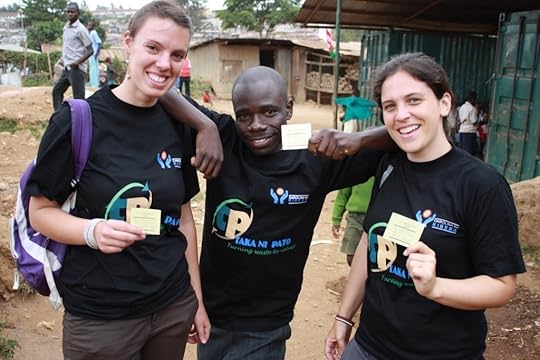
Lindsey and I with our "certificates".
Follow Chelsea's blog at- http://haveitoldyoulatelythat.blogspot.com/
[image error]
[image error]
[image error] [image error]
[image error]
June 9, 2011
Welcome to New Program Officers, Sarah and Hellen
We are thrilled to introduce to you our two new Daughters United (Binti Pamoja) Program Officers:
Ms. Sarah Waithera and Ms. Hellen Onyango
Ms. Sarah Waithera has been a Program Assistant and recently an Assistant Program Officer under the Binti Pamoja Program. Sarah, holds a Diploma in Community Development and is currently pursuing a BA in Social Communication. Sarah brings her homegrown experience with CFK and the Binti Pamoja Program to the new program phase. Her amiable personality and deep understanding of community dynamics makes her an asset to this program. Ms. Hellen Onyango recently graduated with a BA in Social Sciences from the Catholic University of Eastern Africa and has worked and interned at several organizations in Nairobi. Hellen is gifted with great presentation skills and a sharp mind.
Sarah and Hellen's mix of complementary skills will be immensely useful to the program as we seek to expand and diversify its interventions in response to the ever-changing needs of Kibera girls. We congratulate the new POs and wish them well as we journey together.
May 27, 2011
Email, Education, and Inflation in Kibera
From CFK Summer 2011 Fellow Kevin Diao:
Today, I traveled with Nick, one of the CFK "youth" (quotations, because youth in Kenya can refer to anyone from 5 years old to 30 years old – Nick is 23 years old) field officers through three of the villages: Kianda, Soweto West, and Raila. These villages are situated on the western portion of Kibera. The CFK main office is located nearby in Olympic Estate. We delivered messages to various secondary schools telling of an upcoming CFK-sponsored discussion. The discussion would address the role of parents in talking to their kids about sex and sexual reproductive health. The journey of twists and turns down thin alleyways and over shaky, wooden ad hoc bridges that connected the two banks of sewage rivers took all of about two or three hours. E-mail probably would have been easier, but in a society that emphasizes formalities (the best example that comes to mind is the way people here are often welcomed and bid farewell to with short, serious, personal "speeches"), hard letters are much more effective and welcomed.
If e-mails were used predominantly, attendance at events would likely be much smaller, some CFK staff members stipulated. So here we were, delivering the letters to the principles of the schools. Along the way, Nick and I discussed our aspirations as well as political turmoil and corruption that plagued Kenya and ultimately resulted in the oppression of Kiberan people – when politics and corruption reign supreme, the poorest of the poor are the ones who lose and pay for it.
Nick is studying law at Mt. Kenya University in Nairobi. He plans to become a lawyer and use his skills to fight for the legal rights of Kiberans. While he generally works from 8-5 AM each day with CFK, he fits in night class that lasts from 5:30PM to 8:30PM at the University. The amount of effort and determination that such a rigorous schedule demands is incredible, yet it is fairly commonplace in the area. While journeying through Raila village (named after the current Prime Minister, Raila Odinga), we ran into one of Nick's good friends, named Reagan. The two have been friends since early in primary school. Reagan graciously led us to his modest but cozy home in Raila. My best guess was that his home was 10 ft by 11 ft or so. He lived there by himself, with a very friendly cat that immediately jumped on me and made himself at home in my lap. There were two sofas, a chair, a coffee table in the middle, and a TV which all but took up the ~110 sq ft. On the wall hung some of his soccer equipment and some Chelsea and Arsenal memorabilia (two soccer English Premier League soccer teams, for those who aren't familiar with it). Reagan told me that this was the first time he had a "mzungu" (the word for white people in Swahili, although it's also occasionally used as an umbrella term for foreigners) visit his home.
Reagan was an amazingly generous host, in true Kenyan fashion, and told me it was a privilege to have me there. I quickly told him, meaning every word, that it really was my privilege to be there. Moments like these are, without a doubt, the most memorable and rewarding. We hung out there and relaxed and just talked about whatever. Later on, another one of their long-time friends named George arrived. While Reagan is studying social work resource management at Kenyatta University, George is also studying law (I believe at Mt. Kenya at well, though I didn't ask). The three used to live in a hostel together, in a room that housed 16 boys in total. Today, Reagan said, 13 of them are left, and they are still a tightly knit group. He proudly talked about how within the group there are [future] lawyers, social workers, accountants, IT specialists, and teachers. One day, he said, the 13 might create an organization for progress in Kibera. This is exactly the kind of powerful and pervasive effect that education can have.
Reagan talked about how because of rampant inflation in Kenya, the friends have slowly had to reduce from three meals a day, to two meals a day, to now, when they eat just one meal a day (supper). We joked about the ridiculously large plates of pilau and ugali that were served as a result, and about taking any kind of quantity over quality in meals. We laughed it off. Bear with the sidetrack here, it'll make sense in a moment, but there is a rumor, or more properly named – prophecy – going around here that the world is going to end on Saturday 5/21, but people everywhere have been talking about it. Anyways, I told the friends that now that the world is ending, they can finally go for quality instead of quantity. They heartily agreed, deciding that they would go for pizza (for the first time) and then would be ready to leave behind the world.
Here are some pictures taken in Raila village of Nick and I, not more than a minute from Reagan's house.
Follow Kevin's blog: http://kevindiao.wordpress.com/
May 20, 2011
Smiles, Hard Work, and Hope
Guest writer and recent visitor to CFK, Robert Gorman, reflects on his visit to Kibera with students from the College of Wooster:
Kibera left a lasting impression on our group as we travelled from the heartland of the United States to Kenya. Eighteen of us ventured from Wooster, Ohio, over the spring break at The College of Wooster. The group included 12 college students, their professor, and five community members. The trip was part of a "People and Cultures of Kenya" college course and was designed to give us a close-in look at the people of Kenya. Prior to traveling to the Western Province for four days in two small villages, a great deal of emotional firepower was packed into a relatively short visit to Kibera and the Carolina for Kibera offices.
The eighteen of us — 16 white, one black and one of mixed race — felt very conspicuous as our bus rumbled down the dirt road as we entered Kibera. The physical appearance of the slum was not a complete surprise to us, as we had spent some time studying Kibera in our class. Nevertheless, driving into Kibera felt surreal.
Although the poverty was overwhelming, my first thought as we drove through the slum was, "There is a lot of entrepreneurship here." We saw day care centers, butcher shops, pharmacies, key-making shops, umbrella repair shops — even an internet café. We could tell that while people were desperately poor, they were engaged in their communities.
We joined four MIT graduate students who also were visiting Carolina for Kibera that day and spent perhaps an hour with about 10 CFK staffers who took turns telling us of their specific jobs and the programs that they ran, and who patiently answered our questions. We then split into two groups. Half of us headed to Tabitha Clinic. The walk to the clinic was something — the smell of the slum, the lack of street signs, the little children greeting us with a loud "How are you?" — as we tracked between structures till we got to the Clinic. The Clinic is a beacon of hope in a distressed place. We were blown away as the health care workers took the time to explain the Clinic to us. My notes from the day called the clinic "staggeringly impressive." As a member of the board of a local nonprofit free clinic in Wooster, I was inspired with the technology, the teamwork of the staff and the passion of the workers.
We returned to the CFK offices and met up with the other half of our group who not only visited the recycling center, they got to go inside a small home in which the head of household was a 10-year-old girl who was in charge of three siblings. She was receiving a scholarship from CFK and was proud to show off her home, unlocking the door to the 120-square-foot "home" she shared with her siblings. The people from our trip who visited that home were clearly shaken by the thought of a 10-year-old girl running a family, and they were astonished at her maturity.
The emotions our group experienced from Kibera were driven home further by our afternoon activity. We boarded our bus and drove about an hour to a tea plantation which was a holdover from colonial times. We had a lovely lunch on linen tablecloths on the lawn of the plantation house, saw some beautiful gardens, had our first encounter with monkeys, and heard a lecture on the growth, harvest and processing of tea. It was an experience that was as troubling as it was lovely. It is very difficult to reconcile the poverty we saw in the morning with the comfort and relative luxury we saw in the afternoon. To the planners of our trip, this was no accident. One of the goals was to make us feel discomfort with the unequal distribution of wealth in the world and to ponder the fortunes of birth.
From two months' hindsight, it is still hard to get our heads around Kibera. Poverty and destitution were extreme, but unhappiness did not appear to match the conditions. We saw many smiles, some hard work, and a lot of hope. Most, if not all, of the people on our trip were very deeply impacted by Kibera. A couple have referred to the visit as a life-changing experience. One cannot help but to be moved in several ways — inspired by the tenacity of the people at CFK who work every day in the face of despair, and motivated to do something, somehow, to make a difference in the Kiberas of our lives.
May 18, 2011
Starting with one
If you do community development work, chances are, you believe in the ripple effect. Sure, metrics and measurable outcomes are important indicators of success. But what about the long-term, often unforeseen, sometimes intangible stories of success? Despite our best efforts, let's face it, we just can't predict the future.
When UNC Alum Lucius Burch started the Burch Fellows Program, he clearly wanted to enrich lives. The program's purpose is to "recognize undergraduate students at the University who possess extraordinary ability, promise, and imagination. It grants up to $6,000 to support self-designed off-campus experiences that will enable them to pursue a passionate interest in a way and to a degree not otherwise possible." In starting the fellows program, it's likely that Burch thought about the value of the investment without really knowing the tangible outcomes that would come. He couldn't know the impact of those experiences on students' lives or what it might lead to. But he knew that providing opportunities like this for students was important. And he invested in creating the opportunity.
Carolina for Kibera co-founder Rye Barcott was a Burch Fellow. In fact, it was that award that allowed Rye to go to Kibera for the first time. If it weren't for that opportunity, he wouldn't have had the means to go. And as we know, that first experience in Kibera sparked something in Rye. (for the full story of how CFK started, read Rye's memoir)
In that same spirit, Carolina for Kibera invests in local leaders in Kibera. We connect talent to opportunity. Our programs have measurable outcomes. But at the end of the day, we do this work because we believe in people. We believe that no matter where you are born, you should have the opportunity to live a healthy, safe, and self-sufficient life. You should be able to realize your dreams and inspire others to do the same.
And so, we believe in the ripple effect. A good deed, an investment, an opportunity will create more good. The Burch Fellows led to Rye co-founding CFK. Rye's $26 grant to the determined Tabitha Festo helped start a clinic that now serves more than 40,000 patients a year. It might take time to see the results, there might be bumps along the road. But investing in one good person, one good idea – is worth it.
Every day, we have the opportunity to start a ripple effect. It always starts with one.
April 10, 2011
CFK on tour: sharing the story
It's hard to believe that CFK co-founder Rye Barcott's book, It Happened on the Way to War: A Marine's Path to Peace (Bloomsbury) was released only 2 short weeks ago. The book tour has already criss-crossed the US and Rye has been featured in several local and national media spots. See below for selected media features.
The book offers a personal and honest look at the successes and failures of two seemingly contradictory forms of service – military and humanitarian service. With social and political uprisings around the world being led by youth and the growth of dense urban settlements on the rise at an alarming rate, one must wonder what does the future hold? Rye offers a unique and inspiring perspective informed by friendships and lessons learned in unlikely, difficult places.
Join us on tour and help us spread the story>>http://ithappenedonthewaytowar.com
MULTIMEDIA
Fighting War and Waging Peace, PRI's the World with Lisa Mullins
It Happened on the Way to War: A Marine's Path to Peace, The Gayle King Show
WEB
Interview: Rye Barcott on the battle between the head and the heart, ONE.org
A Captain's Double Life in Kenya and Iraq, Marine Corps Time
"A thoughtful examination of the nature of service and the effects of violence on the human spirit.", Kirkus Reviews
War and idealism: He wrote the book, Raleigh News and Observer, Charlotte Obersever
Faces of Humanitarianism, The Officer
A story for all Tar Heel 'doers,' The Daily Tar Heel
March 29, 2011
2 Forms of Service. 1 Inspiring Book.
Today is a special day. Today CFK co-founder Rye Barcott's memoir launches.
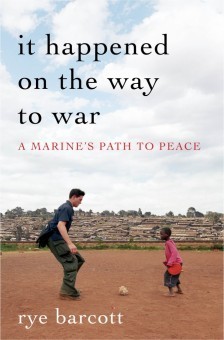 It Happened on the Way to War: A Marine's Path to Peace (Bloomsbury) by Rye Barcott is about the melding of social entrepreneurship and military service, and the power of small groups of committed citizens to make a difference. In 2000, as an ROTC student at UNC-Chapel Hill, Rye sought to understand ethnic violence in preparation to be a Marine. He studied Swahili and spent half a summer living in the Kibera slum of Nairobi, Kenya, where he stumbled into friendship with a widowed nurse, Tabitha Atieno Festo, and a tough community organizer, Salim Mohamed. Together they built Carolina for Kibera using a model of participatory development to break cycles of violence and spark change from within. Rye continued his leadership in CFK while fulfilling his military duties. He struggled with the stress of leading Marines in dangerous places and carried lessons from Kibera in an attempt to become a more effective counter-insurgent.
It Happened on the Way to War: A Marine's Path to Peace (Bloomsbury) by Rye Barcott is about the melding of social entrepreneurship and military service, and the power of small groups of committed citizens to make a difference. In 2000, as an ROTC student at UNC-Chapel Hill, Rye sought to understand ethnic violence in preparation to be a Marine. He studied Swahili and spent half a summer living in the Kibera slum of Nairobi, Kenya, where he stumbled into friendship with a widowed nurse, Tabitha Atieno Festo, and a tough community organizer, Salim Mohamed. Together they built Carolina for Kibera using a model of participatory development to break cycles of violence and spark change from within. Rye continued his leadership in CFK while fulfilling his military duties. He struggled with the stress of leading Marines in dangerous places and carried lessons from Kibera in an attempt to become a more effective counter-insurgent.
In reflecting about the book, Rye writes "Hopefully it will help inspire and inform other citizens (especially college students) to serve and apply a participatory approach to the communities that they are connected to, in or out of uniform, at home or abroad."
Join us for the book tour. Dates >> ithappenedonthewaytowar.com
"Rye Barcott has given us a truly amazing memoir — humane, harrowing, inspiring, and complex in its portrayal of an almost paradoxical accommodation between Eros and Thanatos. This is at least as much a compassionate and emboldening manifesto as it is a work of autobiography." – Tim O'Brien, author of THE THINGS THEY CARRIED
"Riveting. A beautifully written memoir that reads like a novel and reveals fundamental truths about good, evil, and our common humanity." –Ishmael Beah, author of A LONG WAY GONE
"Rye Barcott's engaging and candid memoir on the catalytic power of participatory development shows us that, whether we are in the slums of the world's biggest cities, in rural Haiti, or on college campuses, we can learn from Tabitha, Salim, and Rye—a nurse, a community organizer, and a young Marine living in urban poverty—about how to fight extreme privation and bring about lasting change."
— Dr. Paul Farmer, professor, Harvard Medical School, and co-founder of Partners In Health
Rye Barcott's Blog
- Rye Barcott's profile
- 7 followers



